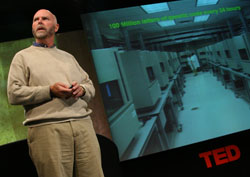 At TED2005 and TEDGlobal, genomics pioneer Craig Venter mentioned — casually, as always — his desire to create a fully synthetic lifeform, preferably one that will serve society’s greater needs. Venter’s work is singularly ambitious, but he’s not the only one with his eyes on that prize. The idea of designing living machines (albeit ones on a very small scale) has captured the imagination of scientists worldwide. “We want to do for biology what Intel does for electronics,” Harvard professor George Church told The New York Times this week. “We want to design and manufacture complicated biological circuitry.”
At TED2005 and TEDGlobal, genomics pioneer Craig Venter mentioned — casually, as always — his desire to create a fully synthetic lifeform, preferably one that will serve society’s greater needs. Venter’s work is singularly ambitious, but he’s not the only one with his eyes on that prize. The idea of designing living machines (albeit ones on a very small scale) has captured the imagination of scientists worldwide. “We want to do for biology what Intel does for electronics,” Harvard professor George Church told The New York Times this week. “We want to design and manufacture complicated biological circuitry.”
It’s still early days, but there have been successes. By stringing together specific chunks of DNA, “synthetic biologists” (as they’re now called) have engineered bacteria to perform simple tasks, like changing color or illuminating under certain circumstances. The aspirations, of course, are far greater: from helping human cells self-police against cancer to creating a microbe that produces hydrogen for use as fuel. And that’s just phase one. For a more complete briefing, the Times piece (Custom-Made Microbes at Your Service) offers an excellent overview. You can expect much more at TED2006 …